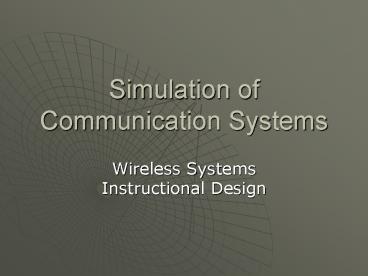Simulation of Communication Systems PowerPoint PPT Presentation
1 / 12
Title: Simulation of Communication Systems
1
Simulation of Communication Systems
- Wireless Systems Instructional Design
2
Simulation hierarchy
Event driven simulations ns2, Opnet
Networks
Packets, messages, flows
Time driven simulations SPW, Cossap,
Simulink/Matlab
Links
Waveforms
DSP
Circuits
RF
Technology
Algorithm simulations TI CodeComposer
Circuit simulations NC-VHDL/Verilog,
Scirroco,
RF simulations PSpice, ADS,XFDTD
3
Waveform Level Simulations
- Usually used when analytical evaluation of
performance is difficult (nonlinearities, ISI
caused by bandlimiting filters) - Typically
- Generate sampled values of the input waveforms
(process) - Process them through system models and generate
output - Estimate the performance by comparing inputs and
outputs
4
Methodology
- Ideally model is a perfect replica of the real
system hard to do - Instead we introduce approximations to reduce
complexity or run-time - Modeling level simplification of the specific
functions - Performance evaluation level estimation of
performance measures
5
Methodology (cont.)
- Modeling
- System Modeling - highest level of description
complexity reduction - Device Modeling block or subsystem (e.g.
transfer function on every clock cycle
"input-transfer-output) - Random Process Modeling
- Source random process (imitated with pseudo
random number generator RNG) - Time-variant random channel
- Equivalent random process (ERP)
6
Methodology (cont.)
- Monte Carlo simulation as the name implies
relates to game of chance - Input signals are assumed to be random processes
- Objective is to find statistical properties of
Model of Communication System
- If we do time evolution of all the waveforms -
pure Monte Carlo simulation - Generating sampled values of all the input
processes
7
Methodology (cont.)
- Procedure
- Generate sampled values of the inputs (e.g. bit
sequence U(k), k1,2,,N and noise V(j),
j1,2,,mN) - Process samples through the model and genarate
Y(k) (received bits) - Estimate the performance by counting errors
- In general find expected value of Eg(Y(t) from
the simulation according to
8
Methodology (cont.)
- For our example
where - If only some input processes are simulated
explicitly partial MC (quasianalytical
simulation) - Random number generation is essential for MC
simulations - Requires RNG generation methods from a wide
variety of distributions and with arbitrary
autocorrelation (PSD).
9
RNG
- Important properties
- Algebraic
- Structure (uncorrelated samples)
- Period
- Statistical
- Distribution
- Uniform RNG
- Congruent or the power residue method
10
RNG (cont)
- where
- Mgt0 large (prime) integer - modulus
- 0ltaltM - multiplier
- c 0,1 increment
- 0 lt X(0) lt M-1 seed
- Generates random sequence of integers 0lt X(k) lt
M-1 - Uniform RNG
11
RNG (cont)
- Few good men (for 32 bit machines)
- For longer periods
- Wichman-Hill Algorithm combines 3 RNGs
-
period
12
RNG (cont)

